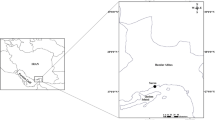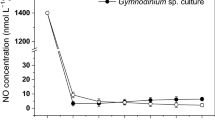Abstract
It has been known for some time that mangroves grow in the intertidal areas of desert countries where fresh water flows into the sea, but this phenomenon has not been understood. In Eritrea we observed that mangroves grow where infrequent rains flow into the Red Sea. We theorized that the fresh water must bring elements needed for plant growth that are absent in seawater. We compared the composition of seawater to that of Zarrouk’s algae medium. All the elements in algae medium are in sufficient quantity in seawater except for nitrogen, phosphorous and iron. If we supply these elements we can grow any plant that can grow in seawater. We have also begun planting plants that can grow in sea water in the Sahara desert with sea water irrigation and fertilization with nitrogen, phosphorus and iron. We believe this will be major step in reducing hunger and poverty in the world.







Similar content being viewed by others
References
Sato G, Fissera A, Gebrekiros S, Karim HA, Negassi S, Fisher M, Yemane E, Teclemariam J, Riley R (2005) A novel approach to growing mangroves on the coastal mud flats of Eritrea with the potential for relieving poverty and hunger. Wetlands 25:776–779
Zarrouk C (1966) Method of culturing algae in an artifical medium. Doctoral dissertation, University of Paris
Acknowledgments
Early in the development of the Manzanar Project an article appeared in the New York times about the project. It was read by Edwin Joseph, and he donated a substantial financial contribution to the project. Thinking about a conversation I had with him at the time and thinking about it many years afterward, I realized that he had a much clearer idea about its potential than I had. With the development of forest and grassy meadows and fertilization of the seas off the Sahara coast, we are beginning to achieve his vision. I am grateful to Mr. Edwin Joseph. I am grateful for the many contributions of scientists as Drs. Don Fawcett. Tatsuo Senshu, Paul Terasaki, Denry Sato, Ko Nishimura, and Bill Moyle, and to many co-inmates of Manzanar including Bruce Kaji, Yoshi and Grace Nakamura, Rosie Kakuuchi, Yuki Tanigawa; and I am grateful to the members of the Manzanar Committee who have lent their prestigious names to the project: Kei Arima, Stanley Cohen, Lawrence Grossman, Niels Jerne, Rita Levi Montalcini, Thomas Maciag, Shingo Nomura, Martin Rodbell, Jesse Roth, Jonas Salk, Howard Schneiderman, Lewis Thomas, Susumu Tonegawa. Gary Trudeau, and James Watson. I thank Susan Roth and Cindy Kane for their encouragement and support. I was chosen to give the Hiroki Murakami Memorial Lecture because Hiroki spent some time in my laboratory where he learned about tissue culture. I decided to talk about the Manzanar Project because I wanted people to know how simple science can have a beneficial effect on man.
Author information
Authors and Affiliations
Corresponding author
Rights and permissions
About this article
Cite this article
Sato, G., Negassi, S. & Tahiri, A.Z. The only elements required by plants that are deficient in seawater are nitrogen, phosphorous and iron. Cytotechnology 63, 201–204 (2011). https://doi.org/10.1007/s10616-011-9342-0
Received:
Accepted:
Published:
Issue Date:
DOI: https://doi.org/10.1007/s10616-011-9342-0




